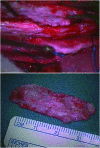Arachnoiditis ossificans associated with syringomyelia: An unusual cause of myelopathy
- PMID: 23637667
- PMCID: PMC3623106
- DOI: 10.1055/s-0028-1100914
Arachnoiditis ossificans associated with syringomyelia: An unusual cause of myelopathy
Abstract
Objective: The pathophysiology of arachnoiditis ossificans (AO) and its association with syringomyelia remains a rare and poorly understood phenomenon. Here, we present a case of AO associated with syringomyelia, a review of literature, and a discussion of current understanding of disease pathophysiology.
Methods: A literature review was performed using MEDLINE (January 1900-May 2010) and Embase (January 1900-May 2010) to identify all English-language studies that described AO with syringomyelia. The current report was added to published cases.
Results: Over 50 cases of AO are reported in literature, of which only eight are associated with syringomyelia. The various presumptive etiologies of syrinx formation include abnormalities in blood circulation, ischemia, hydrodynamic alternations in cerebrospinal fluid (CSF) flow, tissue damage, or incidental coexistence. Changing CSF dynamics related to decreased compliance of the subarachnoid space and subsequent paracentral dissection of the spinal cord may be implicated in the disease process. magnetic resonance imaging (MRI) scanning may identify the syrinx but fail to diagnose the calcified arachnoid. Five patients, including the current case, improved clinically following laminectomy and decompression.
Conclusions: Syringomyelia in association in AO is a rare phenomenon. A high index of suspicion is required and both MRI and computed tomography (CT) are recommended for diagnosis. The pathophysiology of syringomyelia in AO remains an area of ongoing research.
Conflict of interest statement
This report has received no financial support.
Figures




References
-
- Kaufman A B, Dunsmore R H. Clinicopathological considerations in spinal meningeal calcification and ossification. Neurology. 1971;21(12):1243–1248. - PubMed
-
- Papavlasopoulos F, Stranjalis G, Kouyialis A T. et al.Arachnoiditis ossificans with progressive syringomyelia and spinal arachnoid cyst. J Clin Neurosci. 2007;14(6):572–576. - PubMed
-
- Nelson J. Intramedullary cavitation resulting from adhesive spinal arachnoiditis. Arch Neurol Psychiatry. 1943;50(1):1–7.
-
- Van Paesschen W, Van den Kerchove M, Appel B. et al.Arachnoiditis ossificans with arachnoid cyst after cranial tuberculous meningitis. Neurology. 1990;40(4):714–716. - PubMed
-
- Kahler R J, Knuckey N W, Davis S. Arachnoiditis ossificans and syringomyelia: a unique case report. J Clin Neurosci. 2000;7(1):66–68. - PubMed
Additional references
-
- Mello L R, Bernardes C I, Feltrin Y. et al.Thoracic spine arachnoid ossification with and without cord cavitation: report of three cases. J Neurosurg. 2001;94 01:115–120. - PubMed
-
- Faure A, Khalfallah M, Perrouin-Verbe B. et al.Arachnoiditis ossificans of the cauda equina Case report and review of the literature. J Neurosurg. 2002;97 02:239–243. - PubMed
Publication types
LinkOut - more resources
Full Text Sources

